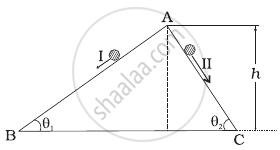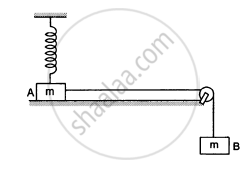Advertisements
Advertisements
Question
Two inclined frictionless tracks, one gradual and the other steep meet at A from where two stones are allowed to slide down from rest, one on each track as shown in figure.

Which of the following statement is correct?
Options
Both the stones reach the bottom at the same time but not with the same speed.
Both the stones reach the bottom with the same speed and stone I reaches the bottom earlier than stone II.
Both the stones reach the bottom with the same speed and stone II reaches the bottom earlier than stone I.
Both the stones reach the bottom at different times and with different speeds.
Solution
Both the stones reach the bottom with the same speed and stone II reaches the bottom earlier than stone I.
Explanation:
As seen in the diagrams, AB and AC are two smooth planes inclined at the angles θ1 and θ2, respectively.
Because there is no friction here, mechanical energy will be preserved.
Because both tracks have the same height h,
`1/2 mv^2 = mg`
`hv = sqrt(2gh)`
Hence, speed is the same for both stones. For stone I, a1 = acceleration along the inclined plane = g sin θ1
Similarly, for stone II, a2 = g sin θ2
And because track II is shorter in length, stone II arrives earlier than stone I.
APPEARS IN
RELATED QUESTIONS
A particle is rotated in a vertical circle by connecting it to a string of length l and keeping the other end of the string fixed. The minimum speed of the particle when the string is horizontal for which the particle will complete the circle is
A block of mass m is attached to two unstretched springs of spring constants k1 and k2 as shown in the following figure. The block is displaced towards the right through a distance x and is released. Find the speed of the block as it passes through the mean position shown.

A small heavy block is attached to the lower end of a light rod of length l which can be rotated about its clamped upper end. What minimum horizontal velocity should the block be given so that it moves in a complete vertical circle?

In the following figure shows two blocks A and B, each of mass of 320 g connected by a light string passing over a smooth light pulley. The horizontal surface on which the block Acan slide is smooth. Block A is attached to a spring of spring constant 40 N/m whose other end is fixed to a support 40 cm above the horizontal surface. Initially, the spring is vertical and unstretched when the system is released to move. Find the velocity of the block A at the instant it breaks off the surface below it. Take g = 10 m/s2.

A spring of negligible mass and force constant 5 Nm–1 is compressed by a distance x = 5 cm. A block of mass 200 g is free to leave the end of the spring. If the system is released, what will be the speed of the block when it leaves the spring?
A particle is released from height S from the surface of the Earth. At a certain height, its kinetic energy is three times its potential energy. The height from the surface of the earth and the speed of the particle at that instant are respectively ______.
A body is falling freely under the action of gravity alone in vacuum. Which of the following quantities remain constant during the fall?
Why is electrical power required at all when the elevator is descending? Why should there be a limit on the number of passengers in this case?
A body falls towards earth in air. Will its total mechanical energy be conserved during the fall? Justify.
A single conservative force acts on a body of mass 1 kg that moves along the x-axis. The potential energy U(x) is given by U (x) = 20 + (x - 2)2, where x is in meters. At x = 5.0 m the particle has a kinetic energy of 20 J, then the maximum kinetic energy of body is ______ J.
